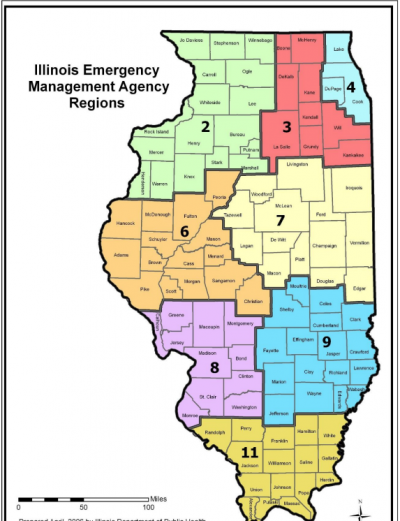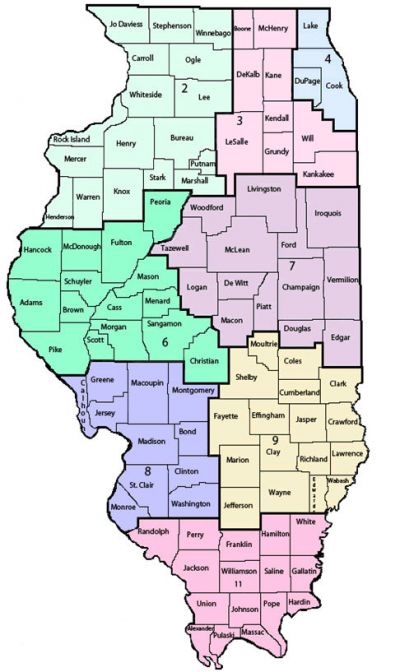Emergency Management Agency and Office of Homeland Security (IL)
From The RadioReference Wiki
(Redirected from Emergency Management and Office of Homeland Security (IL))
Return to the Illinois Emergency Management Agency and Office of Homeland Security (IL) database page
Contents
Illinois Emergency Management Agency and Office of Homeland Security (IEMA-OHS)WEB X FB IG YT
- 2/17/23 - Governor JB Pritzker submitted an Executive Order to change the official name of the Illinois Emergency Management Agency to the Illinois Emergency Management Agency and Office of Homeland Security (IEMA-OHS). This aligns more with what the Federal Government is doing with FEMA being under Homeland Security.
- The state utilizes redundant systems employing HF, VHF Low,VHF High, UHF, 700/800 MHz conventional radio and 700/800MHz Project 25 trunked radio platform (STARCOM21) in fixed and mobile configurations, amateur radio, microwave, satellite, Illinois Century Network (ICN), digital messaging and common carrier telephone/cellular systems.
- The primary IEMA Operations Center is located at 2200 South Dirksen Parkway, Springfield IL.
- The alternate IEMA Operations Center is located at 4800 Rodger Street, Springfield IL
Communications
- Communications Center - 800-782-7680 or 217-782-7680
- AUXCOMM is the cadre of trained communications volunteers credentialed by a governmental agency, possessing specialized skills that may be called upon to support the Incident Command System during local, regional, state, and national level exercises, events, and incidents. Auxiliary communications are a general term for communications support to emergency management, public safety, public health, NGOs and private entities by volunteers using amateur radio, or other radio resources outside the Public Safety radio service
- Regions Contacts and Map
ESMARN Emergency Services Mutual Aid Radio Network
155.025 CSQ/123.0* 155.025 123.0 Emergency Management EMA
- CTCSS Tones – Default operation should be carrier squelch receive (CSQ), CTCSS Transmit. If the user can enable/disable without programming the radio, the indicated CTCSS tone also could be programmed for receive, and the user instructed how and when to enable/disable.
- The Emergency Services Mutual Aid Radio Network (ESMARN) is utilized throughout the state as an emergency management mutual aid channel. ESMARN is widely used in Illinois at the local emergency management agency level, providing a communications path for dispatch and notification as well as interoperability.
- In Illinois and its adjoining states, the frequency known as ESMARN is used for local events where mutual aid and/or event notification is required. The use of ESMARN at the local level is both mobile-to-mobile and base-to-mobile communications. ESMARN is used by many local departments for paging of emergency management personnel as well as local services such as police, fire, and medical services.
Homeland Security
ITTF Channel Line-Up 700/800 MHz Illinois Terrorism Task Force (ITTF) Homeland Security Regions Map & Talk Group Listing
1 IESMA Statewide 2 ILEAS Statewide 3 MABAS Statewide 4 IL Public Health Department Statewide 5 ITTF Incident 1 Statewide 6 ITTF Incident 2 Statewide 7 ITTF Incident 3 Statewide 8 ITTF Region 01 9 ITTF Region 02 10 ITTF Region 03 11 ITTF Region 04 12 ITTF Region 05 13 ITTF Region 06 14 ITTF Region 07 15 ITTF Region 08 16 ITTF Region 09 17 ITTF Region 10 18 ITTF Region 11 19 ITTF Region 12 20 ITTF Region 13 21 ITTF Region 14 22 ITTF Region 15 23 ITTF Region 16 24 ITTF Region 17 25 ITTF Region 18 26 ITTF Region 19 27 I-CALL (156.7 PL Conventional) 28 I-TAC 1 (156.7 PL Conventional) 29 I-TAC 2 (156.7 PL Conventional) 30 I-TAC 3 (156.7 PL Conventional) 31 I-TAC 4 (156.7 PL Conventional)
Interoperable Communications
- Interoperable Communications Illinois Interoperability Field Operations Guide (12/20) Law (5/24)
- Statewide Communications Interoperability Plan (SCIP)(2016)
- Tactical Interoperable Communications Plan (TICP) All Illinois Agencies (PDF 9/24)
GLOSSARY
Acronym Definition '''Homeland Security Acronyms ''' CASM Communication Assets Survey and Mapping COMC Communications Coordinator COML Communications Unit Leader COMT Communications Technician ICS Incident Command System ILTERT Illinois Telecommunications Emergency Response Taskforce INCM Incident Communications Center Manager ITECS Illinois Transportable Emergency Communications System MCC Mobile Communication Center MHz Megahertz NIP National Interoperable Pool NIMS National Incident Management System RADO Radio Operator SCIP Statewide Communications Interoperability Plan SEOC State Emergency Operation Center SIEC Statewide Interoperability Executive Committee SOP Standard Operating Procedure SOW Site On Wheels (STARCOM21) STR Strategic Technology Reserve SWIC Statewide Interoperability Coordinator THSP Technical Specialist TICP Tactical Interoperable Communications Plan TST Technology Support Teams UAC Unified Area Command vehicle UCP Unified Command Post (vehicle)
Illinois Department of Nuclear Safety WEB
- 11 operating commercial nuclear power reactors at six sites generate about 50 percent of Illinois' electricity. There are also three commercial nuclear power reactors no longer operating: two at Zion and one at Dresden. In addition, there is an inactive reprocessing facility near Morris, Illinois. (Over 440 nuclear power reactors generate about one-sixth of the world's electricity. Over 100 power reactors generate about 22 percent of the Nation's electricity.)
In Illinois electricity is generated by two types of power reactors: Boiling Water Reactors (BWRs) and Pressurized Water Reactors (PWRs). BWRs are located at the Dresden, Clinton, LaSalle, and Quad Cities Stations; PWRs, at the Braidwood and Byron Stations.
Radiological Emergency Response (RTF)
- Responds to nuclear power plant and other radiological emergencies in Illinois. The RTF consists of two components, the Radiological Emergency Assessment Center (REAC) in Springfield and the Radiological Response Group (RRG). REAC provides an independent assessment of the event, develops dose projections, and provides protective action recommendations for the public to the State Emergency Operations Center. To confirm the projections performed in REAC, RAFT personnel are dispatched to the affected area to measure radiation in the environment, collect environmental samples, ensure contamination control and sample chain of custody, analyze samples and coordinate with other field responders
(Old Frequencies)
- F1 155.4750 ISPERN
- F2 ISP District Chicago
- F3 155.0550 CSQ I-REACH
- F4 155.4600 CSQ HF-4
- F5 155.0250 CSQ ESMARN
- F6 155.3400 MERCI-1 Statewide
- F7 155.9250 CSQ Admin
- F8 155.0850 CSQ Springfield Area
- F? 44.9200 CSQ Springfield Area


